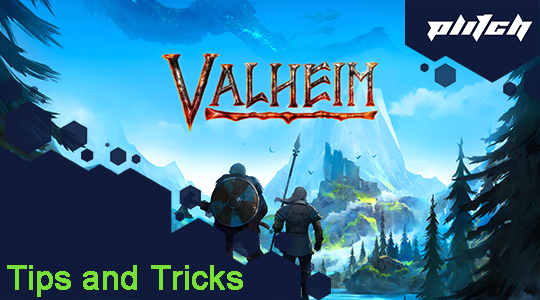In Valheim you’ll play as a fallen warrior who, after his death, is taken to Valheim, the Viking purgatory. To survive in this world, you’ll have to search for materials and build houses to live in.
Our Valheim building guide will help you avoid frustrating moments when building your houses and tell you how and where you should build a base.
Table of Contents
1) How and where should you build a base?
For your first base, you don’t need much. As the game progresses, you’ll expand or even relocate it anyway. In the beginning, a hammer, some wood, and a workbench with a roof are enough to get started. Our recommendation is not to wait too long before building your first four walls. The night will come sooner than you think, and when it does, you should be protected from both danger and cold.
As for the perfect location for your home, there are a few basic things you should keep in mind. Preferably, build your cabin near a body of water, preferably so that you are not far from the sea. You should also look for flat places. You can also use a pickaxe to work the terrain according to your wishes, but this means effort. For your first base, you don’t need to do this yet.
From experience, the best place to build your first house is in the floodplain forest. From there you have good access to different areas and biomes. This way, if you want to farm ores, you won’t have to go far, and you’ll always find plenty of wood, food, and other important resources there. However, the Black Forest or the mountains are not bad areas to settle down either.
As said before, in the course of the game you will always change your location anyway. In the beginning, it’s only important that you are protected, stay warm, and store your items temporarily. You should stay away from the Plains at the beginning. It’s dangerous there and the weather conditions are difficult for beginners.
2) Basic building tips
Once you’ve chosen the ideal place for your house, you can start building. The first step is to set up a workbench. To unlock the blueprint for it, you first need to make a hammer. For this, you need two pieces of wood and two units of stone. You can then use the hammer to open the building menu, go to the crafting tab and place the workbench where you want it.
The next step is the foundation. If the ground is not flat, you must first work the ground with a hoe or pickaxe. No soil must be in the way when you lay the boards. You can also find them in the construction menu. There you have the choice between 2×2 or 1×1 fields with large wooden floors. Just place the boards on the leveled ground as you like.
By the way, it doesn’t matter if you’re not satisfied with the construction later. You can always tear down all the components again and get back the raw materials without loss. So, trial and error are no problem. To tear down parts, you mark them with your hammer and press the middle mouse button. If you hit them with a pickaxe or axe, you can also remove them, but you won’t get any resources back.
After the floor, it’s time for the walls. Each wall piece requires 2 pieces of wood. Place them flush around your foundation. Use the mouse wheel to rotate them in the appropriate direction and the shift key to compensate for overlaps. This way you can design your home exactly as you have it in mind and are not bound to the dimensions of the objects. Without supports, by the way, you can build with wood up to 4 parts in height and 8 parts in width.
The last step for your first – simple – house is the roof. Here, too, you will need 2 pieces of wood per element. Therefore, collect enough wood before building. Of course, the best way to do this is to cut trees. The easiest way to do this is with an axe. But it’s also possible without one: In Valheim, you can smash smaller trees by hitting them with your fists. This is not an elegant solution, but it will still get you there.
3) Valheim Building Guide: The stability system
The stability of your dwelling plays a big role in Valheim, which makes it very different from other survival games like Conan Exiles. The focus is more on realism. But with our Valheim tips on the building system, you’ll avoid collapses and get your base statically correct and on safe footing.
If you want to build not just a hut, but a real house, then supporting pillars are essential. Basically, the construction is similar to the real construction of a barn. By building your foundation on pillars, you level out the uneven ground, and with cross braces, you provide more stability. Make sure that you not only support the edges of a large foundation but also provide good support in the middle.
To prevent your house from collapsing in a storm or if it is later enlarged, you must ensure that there are not too many building elements between the individual supports. This applies to both horizontal and vertical alignment. First, set the supports at the correct spacing. As already mentioned, for wood this is 4 or 8 spaces. This is different for stone – every two elements must be supported. But with stone, you can build real castles and fortresses.
4) The color system
When you build something, you’ll notice that the components you want to place take on certain colors during the building phase. These indicate how solidly they fit into the existing construction.
Blue
Let’s start with the color blue. These are parts that will never collapse without outside intervention and on which the rest of your construction is based.
Dark Green
The dark green color indicates that the component will be very stable and capable of supporting other parts. In the best case, all your support columns will be dark green. The same applies to floor plates that are not directly connected to the ground but are on pillars.
Light Green
Light green is the perfect color when you build walls and roofs. If they shine in the color, it means that they are solid and firm. Unfortunately, such stability requires a lot of supporting pillars at a small distance, so you have to slalom inside the house to go through the rooms. So, in reality, it will often be the case that your walls and roofs will be orange.
Orange
Orange components aren’t necessarily a bad thing. Especially with large roofs, it is difficult to achieve a better stability level. Orange is still stable enough to reliably support your construction. Only if you extend your house later, you should think about reinforcing orange parts before they turn red.
Red
And speaking of red: If possible, you should think about if you really want to use the component. In a storm or when trying to extend the element, it can break. So, consider maybe using an additional wall, crossbars, or more pillars.
Breaking Parts
The last color isn’t really one. Breaking parts light up red briefly, break, and go back into your inventory as resources. They are not a loss, but they show you that your plan to place the element is not working yet and that you have to improve the statics first.
5) Building tips for advanced players
If you want to build a longhouse or other complicated structures like a real Viking, there are a few additional things to consider. So here are our pro tips for advanced builders. What many players don’t know: You can also fan out your floor panels to build round. By sliding the elements into each other, almost all imaginable geometric shapes are possible and you can give free rein to your creativity.
However, fanning out is sometimes a matter of millimeters. Here you need a steady hand because if you move the elements too far or not far enough, the editor will reach its limits and clipping errors will occur. If you want it to be perfect, you have to be prepared to tear down the parts again and again and rebuild them until you are completely satisfied.
The next pro tip is to use a smoke extractor. After all, you don’t want your avatar to die of carbon monoxide poisoning. Valheim is not only a realistic game in terms of statics but also in terms of the survival aspect. So, in small to medium houses, you put a chimney and in long houses, it is best to use a roof cross or raised gable.
The latter also has the advantage that you need to support the roof less than a flat roof. Finally, a gable itself is a load-bearing structure, so you can do without some of the pillars and thus get more freedom of movement inside.
How can you build things even easier & faster?
Valheim has generated a lot of hype for a reason. The game is fun and a breath of fresh air in the survival genre. Thanks to our Valheim Building Guide, building should be easy for you now. However, it’s still a long and literally rocky road to the first longhouse. To reach your goal sooner and without drudgery, the Valheim cheats from PLITCH will help you.
For example, set the carrying weight to zero so that you don’t have to go to the base with full bags all the time, but can farm as much as you want. Or increase the amount of your items so that you can build your dream house right away and don’t have to laboriously collect materials. You can also change your running speed and jumping power to make your movement more comfortable. And to avoid being overrun by enemies, there is also a Godmode or the possibility to deal Super Damage as well as set your stamina to the maximum.
Happy Gaming!


